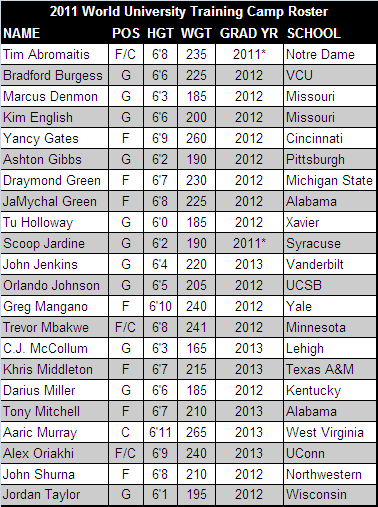2011 World University Finalists – Will the Next NPOY Be Buried on the Bench Again?
Posted by rtmsf on June 8th, 2011As summer heats up, the various Team USA basketball rosters also start rounding into shape. One of the better such international events that includes collegians, the World University Games, is scheduled to occur from August 13-23 in Shenzhen, China. As such, the training camp roster of 22 current college players was released on Wednesday with a goal of cutting the group to a final 12 in late July. The remaining dozen will spend early August practicing as a team before traveling overseas to represent the United States in an event that hasn’t been kind to the Yanks in the last decade. Perhaps as a result of increasingly fewer talented players still in college or representative of the world catching up to the USA in basketball, this team has only finished first or second once in its last four outings — the 2005 team led by Shelden Williams (Duke) went 8-0 on its way to collecting gold in Turkey. Two years ago, the 2009 team went 7-1 with its sole blemish a one-point semifinal defeat to Russia to bring home the bronze. This year’s team will have its work cut out for it in an increasingly competitive international landscape. Here’s the training camp roster:
It’s a guard-heavy group, as Pitt’s Ashton Gibbs, Xavier’s Tu Holloway, Vanderbilt’s John Jenkins, and Wisconsin’s Jordan Taylor all have All-America potential in 2011-12. This isn’t surprising, as many of the better big men in the game have either opted out of international basketball this summer (Kentucky’s Terrence Jones; Ohio State’s Jared Sullinger), or they’re moving on to NBA riches (Arizona’s Derrick Williams; Georgia’s Trey Thompkins; Kansas’ Morris Twins; Purdue’s JaJuan Johnson). It’s notable that Syracuse’s Scoop Jardine (2010), Northwestern’s John Shurna (2010, 2009), Kentucky’s Darius Miller (2009), Gibbs (2009), and Alabama’s JaMychal Green (2008) have all had previous international experience, which would presumably give each a leg up to make Jim Boeheim’s team this summer.
The conventional wisdom is that playing international basketball on a team like this helps players develop by playing against skilled competition from around the globe in actual-game environments. It makes sense on its face, but we were wondering if player performances on these teams could help predict breakout stars the following year. Let’s take a look:
-
2001: Maryland’s Juan Dixon (19.3 PPG, 3.o SPG) and Lonny Baxter (15.0 PPG and 6.3 RPG) led the way for Team USA prior to both players’ senior seasons. Both were already very well-known commodities (both all-ACC selections, and in Dixon’s case, a 2001 All-American), so there was no surprise here. The third, fourth and fifth leading scorers were also established players at the time — Roger Mason, Jr. (Virginia), Melvin Ely (Fresno State), and Lynn Greer (Temple).
-
2003: USA Basketball did not field a World University team.
-
2005: This gold-medal winning team featured Duke’s Shelden Williams (14.9 PPG, 9.3 RPG, 2.2 BPG), Boston College’s Craig Smith (13.9 PPG, 5.4 RPG), Villanova’s Randy Foye (12.3 PPG, 2.3 APG, 2.4 SPG), and Minnesota’s Vincent Grier (11.1 PPG, 4.6 RPG, 3.3 SPG) as its star players. All rising seniors in the Class of 2006, each was a known commodity at this point and there weren’t any surprises here either.
-
2007: In a somewhat weird situation, USA Basketball sent the entire Northern Iowa team to represent the United States in this year’s competition. The team finished in ninth place in Thailand, and the Panthers showed no improvement in the following 2007-08 season as a result (finishing with a near-identical record as the prior season). However, the core of UNI’s dream season squad of 2009-10 were freshmen and sophomores on that team, so perhaps the experience helped lay the groundwork for its success a couple of years later.
-
2009: In head coach Bo Ryan’s platoon system, most of the better players on this bronze-medal team showed improvement between years after playing on this team, but there were no real breakouts among Talor Battle (Penn State), Deon Thompson (UNC), Gordon Hayward (Butler), Da’Sean Butler (West Virginia), Corey Fisher (Villanova), Quincy Pondexter (Washington), and so forth. Perhaps Pondexter, who went from pretty good player to Pac-10 POY in 2009-10. The real surprise on this team, though, was the performance from a player who would go on to become the NPOY the very next season — Ohio State’s Evan Turner. Although he dished out 18 assists in seven games, he was second-lowest on the team in FGAs (ahead of defensively-oriented Jarvis Varnado) and he only averaged 4.o PPG and 3.7 RPG, which makes you wonder what Bo Ryan was thinking that summer?
Knowing this, and if recent history is any indication, we shouldn’t expect any major breakout candidates from this year’s group either. The thing is, though, that you never really know — maybe Yale’s Greg Mangano or Alabama’s Tony Mitchell will be the next under-utilized pending NPOY on a Team USA World University team.











































